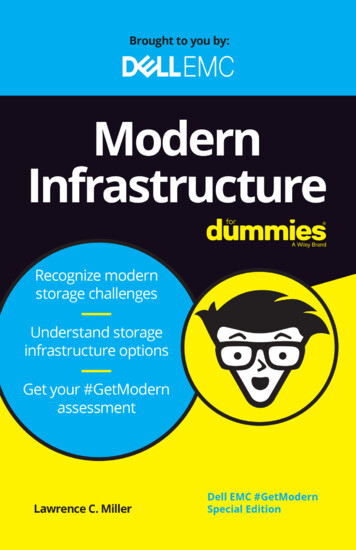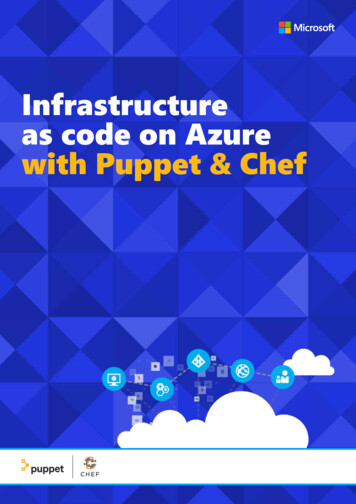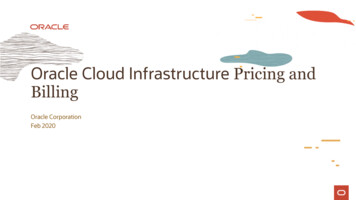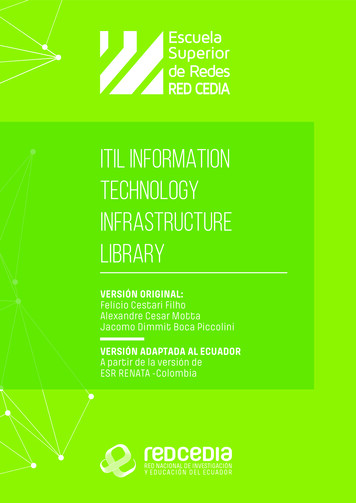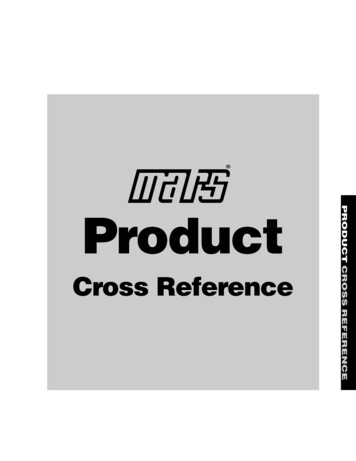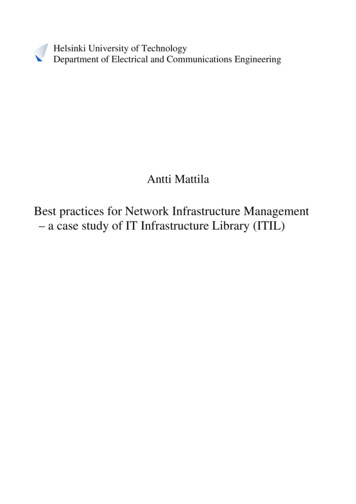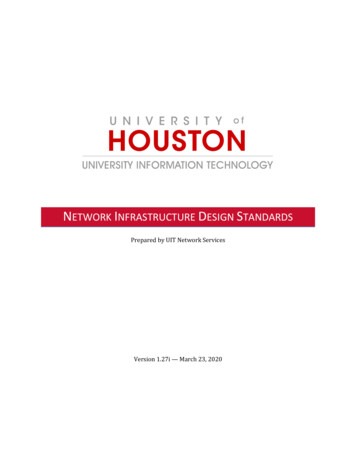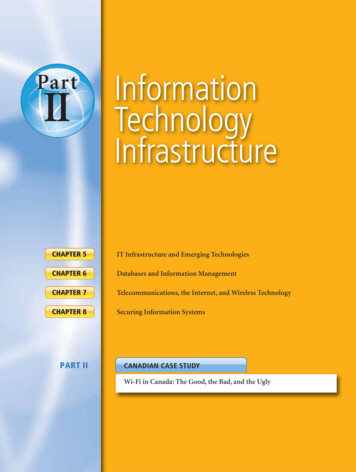
Transcription
PartIIInformationTechnologyInfrastructureCHAPTER 5IT Infrastructure and Emerging TechnologiesCHAPTER 6Databases and Information ManagementCHAPTER 7Telecommunications, the Internet, and Wireless TechnologyCHAPTER 8Securing Information SystemsPART IICANADIAN CASE STUDYWi-Fi in Canada: The Good, the Bad, and the Ugly
CHAPTER 5LEAR N I NG OB J ECTIVESIT Infrastructureand EmergingTechnologiesAfter reading this chapter, you will beable to answer the following questions:1. What is IT infrastructure, and what are itscomponents?2. What are the stages and technology drivers ofIT infrastructure evolution?3. What are the current trends in computerhardware platforms?4. What are the current trends in softwareplatforms?5. What are the challenges of managing IT infrastructure, and what are management solutions?OPENING CASEBell Canada Uses Virtual DesktopIT Infrastructure to Connect 1700 DesktopsBy 2004, Bell Canada employed 8000call centre agents, one of the largestsuch staffs in Canada. These agentsserved more than 27 million customerconnections throughout Canada. Asthe largest subsidiary of Bell CanadaEnterprises (BCE), the company was facing outdated hardware and rising costsin its call centres.By 2004, Bell Canada offered anumber of services, including local,mobile, and long-distance telephoneservice; Internet access; and satellitetelevision, all to both business and residential customers. It continues to offerthese services. Today the companyemploys 44 000 people. With its current desktop systems, Bell faced hardware that was quickly becomingoutdated and would need replacingalong with rising costs of maintaining itscurrent infrastructure environment.For its call centre agents, Bell Canadaneeded a “lockdown” environment that132could accommodate “fat clients” (a fatclient is a client computer with most ofits resources, e.g., processing power,software, and data on the fat clientinstead of the server). What this meansis that the company needed to be ableto extend its own local area network(LAN) to the client’s building and enablea few people to work in a locked roomto meet the security needs of the client.(A LAN is a network that is housed inone building or on one floor of a building; it has a limited geographic scope.)Because Bell Canada used multiple protocols for security, it was a complex environment to try to function in. ExplainedMartin Quigley, a senior technical consultant to Bell Canada, who worked atCGI Group, Inc., “You couldn’t install programs, you couldn’t install anything onthe hard drive because they used filesharing. So they had to keep it in alocked room. It was difficult to manage,and it was expensive.”CGI had been providing consultingservices for Bell Canada since 1993when Bell Canada decided to outsource its IT operations, and CGI wascontracted to provide IT solutions forthe company. Quigley explained thecurrent situation: “Bell Canada came tous with a project to provision, connect,and securely deploy 400 desktop environments within three weeks.” BellCanada and CGI evaluated severalpossible solutions before deciding touse virtual servers. They determinedthat using many different physicalservers is difficult to manage centrallywhile virtual servers by definitionenable multiple servers to run on onecomputer because updates and security must be managed on only onecomputer instead of several differentcomputers. Using virtual servers is alsoless expensive than using the manycomputers required by physical servers.Users connect to a virtual server just as
they do to any server, using the localarea network.Using this virtualization technology,Bell Canada lowered its total cost ofownership by using a single server toreplace several desktops and byemploying a single network connectioninstead of multiple, more expensive network connections. By using the servers“off-site,” Bell Canada also reduced thenumber of site visits by staff to deal withcomputer problems or upgrades. Byusing virtual servers, Bell Canada alsoeliminated the need to ship hardwareand applications to remote teleworkersand to have couriers ship and returnolder hardware from remote locations.By using virtual servers, Bell Canadahas been able to hire more people towork from remote locations who cantelecommute on a daily basis. “We don’thave to worry about security or the difficulty of setting up their environments,”said Quigley. Neither developers norusers can tell the difference betweenthe use of virtual servers and physicalservers since, to them, they are simplyconnecting to “a server”; regardless ofthe type of server, it looks the same toeveryone except the server administrator. Management of the computing environment has been greatly simplified,and it is both easy and fast to deployadditional desktops.Since the virtual servers are attachedto storage area networks (SANs) whichhouse data physically at various locations but with networked access to thedata (see Chapter 6) established by BellCanada, backup and disaster recoveryare easier and faster. Their additionalbackup servers can take over the loadwithin 25 minutes of a server crashing.When Bell Canada began this projectmore than 15 years ago, the companywanted to place 400 desktops in a virtual server environment. By partneringwith CGI Group and its partner, VMware,Bell Canada now uses its virtual serverenvironment for 1700 desktops, whichhas led to further cost savings. VMwareis a company that specializes in softwareto consolidate physical servers into a virtual server.It is interesting to note that a yearafter CGI helped Bell Canada to implement its virtual server environment in2004, BCE decided to sell its stake inCGI, which it had acquired in 1995;the sale amounted to close to US 1billion. BCE had purchased its 100 million shares in CGI in 1995, after BellCanada’s first consulting contract withCGI, and was considered a “friendly”buy-back. This could be said to represent an interesting use of “insider”consulting.Sources: John D. Blau, “BCE to Sell Stake inCanadian IT Service Provider CGI,” Infoworld,December 19, 2005, www.infoworld.com/article/05/12/19/HNbcestake 1.html?IP%20TELEPHONY (accessed February 13,2009); VMware, “VMware Virtual DesktopInfrastructure Connects Bell Canada forOptimized Customer Care,” 2006,www.vmware.com/files/pdf/customers/06Q3 cs vmw Bell Canada English.pdf(accessed February 13, 2009; CGI, “CGIProvides HR Self-Service Solution to BellCanada’s Employees, www.cgi.com/web/en/library/case studies/71182.htm(accessed February 13, 2009).133
134 Part II Information Technology InfrastructureBusinessChallenges Outdated hardware Rising costs Decide how to ensuresecurity Replace hardware atlow cost Update desktopsfrequently at low cost Management IS Personnel CGI BusinessSolutions Virtual server software Virtualization Storage area networks(SANs)TechnologyBell Canada has an enviable trackrecord as a successful telecommunication business. Unfortunately, its growthplans and daily operations were hampered by unmanageable and outdatedserver technology. Bell Canada’s management felt the best solution was to replaceits antiquated server infrastructure withnew computer hardware and softwaretechnologies and to standardize using thetechnology of a single vendor—VMware.This case highlights the critical role thathardware and software investments canplay in improving business performance.The chapter-opening diagram callsattention to important points raised bythis case and this chapter. Managementdecided that the best way to maketechnology promote business objectives was to overhaul and standardize IT Easy to replacehardware at anydesktop Lower costs of bothmanagement andpower consumptioninfrastructure. Bell Canada now uses amore efficient and easily managedserver environment that makes it mucheasier to deploy additional desktopswhile maintaining security and control.The entire infrastructure is easier tomanage and capable of scaling up toaccommodate additional desktops,growing transaction loads, and newbusiness opportunities.5.1 IT InfrastructureIn Chapter 1, we defined information technology (IT) infrastructure as the shared technologyresources that provide the platform for the firm’s specific information system applications.IT infrastructure includes investment in hardware, software, and services—such as consulting, education, and training—that are shared across the entire firm or across entire businessunits in the firm. A firm’s IT infrastructure provides the foundation for serving customers,working with vendors, and managing internal firm business processes (see Figure 5-1).In 2008, supplying firms around the world with IT infrastructure was a 2.09 trillion industry when telecommunications, networking equipment, and telecommunications services (Internet, telephone, and data transmission) are included. In 2009, withthe global economic crisis, global IT spending is expected to decline by about 6 percent to 1.97 trillion. This is the first decline in global IT spending since 2002, immediately after the “dot-com bubble” burst. However, future predictions are that global ITspending, by 2010, will increase by between 6 percent and 15 percent (Woodie, 2009;Ortutay, 2009; Ogg, 2008). Investments in infrastructure account for between 25 and35 percent of information technology expenditures in large firms (Weill et al., 2002).
Chapter 5 IT Infrastructure and Emerging Technologies 135FIGURE 5-1Connection between the firm, IT infrastructure, and business capabilities.The services a firm is capable of providing to its customers, suppliers, and employees are a direct function of itsIT infrastructure. Ideally, this infrastructure should support the firm’s business and information systems strategy.New information technologies have a powerful impact on business and IT strategies, as well as the services thatcan be provided to customers.Defining IT InfrastructureIT infrastructure consists of a set of physical devices and software applications that arerequired to operate the entire enterprise. But IT infrastructure is also a set of firm-wide services budgeted by management and comprising both human and technical capabilities.These services include the following: Computing platforms used to provide computing services that connect employees, cus tomers, and suppliers into a coherent digital environment, including large mainframes,desktop and laptop computers, personal digital assistants (PDAs), and Internet“appliances.”Telecommunications services that provide data, voice, and video connectivity toemployees, customers, and suppliers.Data management services that store and manage corporate data and provide capabilities for analyzing the data.Application software services that provide enterprise-wide capabilities such as enterprise resource planning, customer relationship management, supply chain management, and knowledge management systems that are shared by all business units.Physical facilities management services that develop and manage the physical installations required for computing, telecommunications, and data management services.IT management services that plan and develop the infrastructure, coordinate IT services with the business units, manage accounting for IT expenditures, and provide project management services.IT standards services that provide the firm and its business units with policies thatdetermine which information technology will be used, and where, when, how, and bywhom they will be used.
136 Part II Information Technology Infrastructure IT education services that provide training in system use to employees and offer man agers training in how to plan for and manage IT investments.IT research and development services that provide the firm with research on potential ITprojects and investments that could help the firm differentiate itself in the marketplace.This “service platform” perspective makes it easier to understand the business valueprovided by infrastructure investments. For instance, the real business value of a fullyloaded personal computer operating at 3 gigahertz that costs about 1000 or a high-speedInternet connection is hard to understand without knowing who will use it and how itwill be used. When we look at the services provided by these tools, however, their valuebecomes more apparent: The new PC makes it possible for a high-cost employee making 100 000 a year to connect to all the company’s major systems and the Internet. The highspeed Internet service saves this employee about one hour per day in reduced wait timefor Internet information. Without this PC and Internet connection, the value of this oneemployee to the firm might be cut in half.Evolution of IT InfrastructureThe IT infrastructure in organizations today is an outgrowth of over 50 years of evolution incomputing platforms. There have been five stages in this evolution, each representing a different configuration of computing power and infrastructure elements (see Figure 5-2). Thefive eras are general-purpose mainframe and minicomputer computing, personal computers, client/server networks, enterprise/Internet computing, and cloud computing.Technologies that characterize one era may also be used in another time period forother purposes. For example, some companies, such as the Bank of Montreal, whichemploys an IBM z Series mainframe, still run traditional mainframe or minicomputersystems. Mainframe computers today are used as massive servers supporting large Websites and corporate enterprise applications.General-Purpose Mainframe and Minicomputer Era (1959 to Present) The introduction of the IBM 1401 and 7090 transistorized machines in 1959 marked the beginningof widespread commercial use of mainframe computers.In 1965 the mainframe computer truly came into its own with the introduction of theIBM 360 series. The 360 was the first commercial computer with a powerful operatingsystem that could provide time sharing, multitasking, and virtual memory in moreadvanced models. IBM dominated mainframe computing from this point on.Mainframe computers eventually became powerful enough to support thousands ofonline remote terminals connected to the centralized mainframe using proprietary communication protocols and proprietary data lines. The first airline reservation systemsappeared in 1959 and became the prototypical online, real-time interactive computingsystem that could scale up to service the whole world.The mainframe era was a period of highly centralized computing under the control ofprofessional programmers and systems operators (usually in a corporate data centre),with most elements of infrastructure provided by a single vendor, the manufacturer ofthe hardware and the software. This pattern began to change with the introduction ofminicomputers produced by Digital Equipment Corporation (DEC) in 1965. DECminicomputers offered powerful machines at far lower prices than IBM mainframes,making possible decentralized computing, customized to the specific needs of individualdepartments or business units rather than necessitating time sharing on a single hugemainframe across the organization.MainframeMinicomputersPersonal Computer Era (1981 to Present) Although the first truly personal computers(PCs) appeared in the 1970s (the Xerox Alto, MITS’ Altair, and the Apple I and II, to namea few), these machines had only limited distribution to computer enthusiasts. The appearance of the IBM PC in 1981 is usually considered the beginning of the PC era becausethis machine was the first to be widely adopted by U.S. businesses. At first using the DOSoperating system, a text-based command language, and later the Microsoft Windows
Chapter 5 IT Infrastructure and Emerging Technologies 137FIGURE 5-2Eras in IT infrastructure evolution.Illustrated here are the typicalcomputing configurationscharacterizing each of the five erasof IT infrastructure evolution.
138 Part II Information Technology Infrastructureoperating system, the Wintel PC computer (Windows operating system software on acomputer with an Intel microprocessor) became the standard desktop personal computer.Today, 95 percent of the world’s estimated 1 billion computers use the Wintel standard.Proliferation of PCs in the 1980s and early 1990s launched a spate of personal desktopproductivity software tools—word processors, spreadsheets, electronic presentation software, and small data management programs—that were very valuable to both home andcorporate users. These PCs were stand-alone systems until PC operating system softwarein the 1990s made it possible to link them into networks.Wintel PCClient/server er architecturesWeb serverApplication serverClient/Server Era (1983 to Present) In client/server computing, desktop or laptopcomputers called clients are networked to powerful server computers that provide theclient computers with a variety of services and capabilities. Computer processing work issplit between these two types of machines. The client is the user point of entry, whereasthe server typically processes and stores shared data, serves up Web pages, or managesnetwork activities. The term server refers to both the software application and the physicalcomputer on which the network software runs. The server could be a mainframe, buttoday server computers typically are more powerful versions of personal computers,based on inexpensive Intel chips and often using multiple processors in a single computerbox. The simplest client/server network consists of a client computer networked to aserver computer, with processing split between the two types of machines. This is called atwo-tiered client/server architecture. While simple client/server networks can be found insmall businesses, most corporations have more complex, multitiered (often called N-tier)client/server architectures in which the work of the entire network is balanced overseveral different levels of servers, depending on the kind of service being requested(see Figure 5-3). For example, CMS, an enterprise-wide software company headquarteredin Toronto, uses a multitiered client/server architecture to manage access by headquartersand global staff as well as customers and developers.For instance, at the first level, a Web server will serve a Web page to a client in responseto a request for service. Web server software is responsible for locating and managingstored Web pages. If the client requests access to a corporate system (a product list or priceinformation, for instance), the request is passed along to an application server. Applicationserver software handles all application operations between a user and an organization’sback-end business systems. The application server may reside on the same computer as theWeb server or on its own dedicated computer. Chapters 6 and 7 provide more detail on otherpieces of software that are used in multitiered client/server architectures for e-commerce ande-business.FIGURE 5-3A multitiered client/server network (N-tier).In a multitiered client/server network, client requests for service are handled by different levels of servers.
Chapter 5 IT Infrastructure and Emerging Technologies 139Client/server computing enables businesses to distribute computing work across aseries of smaller, less expensive machines that cost much less than minicomputers or centralized mainframe systems. The result is an explosion in computing power and applications throughout the firm.Novell Netware was the leading technology for client/server networking at the beginningof the client/server era. Today Microsoft is the market leader with its Windows operatingsystems (Windows Server, Windows Vista, Windows XP).Enterprise/ Internet Computing Era (1992 to Present) In the early 1990s, firmsturned to networking standards and software tools that could integrate disparate networksand applications throughout the firm into an enterprise-wide infrastructure. As theInternet developed into a trusted communications environment after 1995, more andmore business firms began using the Transmission Control Protocol/Internet Protocol(TCP/IP) networking standard to tie their disparate networks together. We discuss TCP/IPin detail in Chapter 7.The resulting IT infrastructure links different pieces of computer hardware andsmaller networks into an enterprise-wide network so that information can flow freelyacross the organization and between the firm and other organizations. It can link different types of computer hardware, including mainframes, servers, PCs, mobile phones, andother handheld devices, and it includes public infrastructures such as the telephone system, the Internet, and public network services. Enterprise infrastructure also requiressoftware to link disparate applications and enable data to flow freely among differentparts of the business, such as enterprise applications (see Chapters 2 and 12) and Webservices (discussed in Section 5.4).Cloud Computing Era (2000 to Present) The growing bandwidth power of theInternet has pushed the client/server model one step further, toward what is called the“Cloud Computing Model.” Cloud computing refers to a model of computing in whichfirms and individuals obtain computing power and software applications over theInternet, rather than purchasing their own hardware and software. Currently, cloudcomputing is the fastest growing form of computing, with an estimated market size in2009 of 9.7 billion, and a projected size of 195 billion in 2012 (Gartner, 2008; MerrillLynch, 2008).Hardware firms IBM, HP, and Dell are building huge, scalable cloud computing centresthat provide computing power, data storage, and high-speed Internet connections tofirms that rely on the Internet for business software applications. Software firms such asGoogle, Microsoft, SAP, Oracle, and Salesforce.com sell software applications as servicesdelivered over the Internet. For instance, more than 500 000 firms in 2009 will use GoogleApps, a suite of Internet-based desktop software applications such as word processing,spreadsheets, and calendars (Hamm, 2008; King, 2008). In 2009, more than 43 000 firmsworldwide will be using Salesforce.com’s customer relationship management software,some on their iPhones (see this chapter’s Window on Organizations).Table 5-1 compares each era on the infrastructure dimensions introduced.Technology Drivers of Infrastructure EvolutionThe changes in IT infrastructure we have just described have resulted from developments incomputer processing, memory chips, storage devices, telecommunications and networkinghardware and software, and software design that have exponentially increased computingpower while exponentially reducing costs. Let us look at the most important developments.Moore’s Law and Microprocessing Power In 1965, Gordon Moore, the co-founderof Intel Corporation, the leading computer chip manufacturer, wrote in ElectronicsMagazine that since the first microprocessor chip was introduced in 1959, the number of components on a chip with the smallest manufacturing costs per component(generally transistors) had doubled each year. This assertion became the foundation ofMoore’s Law. Moore later reduced the rate of growth to a doubling every two years.WindowsCloud computingMoore’s Law
140 Part II Information Technology InfrastructureTABLE 5-1 Stages in IT infrastructure evolution.ENTERPRISE/INTERNETERA (1992 TO PRESENT)CLOUDCOMPUTING ERA(2000 TO lesforce.comIBMWintel computersWintelcomputersMultiple: Mainframe Server ClientRemote serversClients (PCs,netbooks, cellphones,smartphones)IBM 360IBM 370UnixDOS/WindowsLinuxIBM 390Windows 3.1WindowsServerLinuxMultiple: Unix/Linux OS 390 Windows ServerLinuxWindowsMac OS XFew ns createdby in-houseprogrammersNo enterpriseconnectivity; boxedsoftwareFew enterprisewide applications;boxed softwareapplications forworkgroups anddepartmentsEnterprise-wideapplications linked todesktop anddepartmentalapplications: mySAP Oracle E-BusinessSuite PeopleSoftEnterprise OneGoogle AppsSalesforce.comNETWORKING/Vendor provided:TELECOMMUNICATIONS Systems NetworkWindowsArchitecture (IBM) DECNET (Digital) AT&T voiceNone or limitedNovell NetWareWindows 2003LinuxAT&T voiceLANEnterprise-wide areanetwork (WAN)TCP/IP Internetstandards–enabledInternetWi-FiWireless broadbandcellular ting andconsulting firmsService firmsSoftware manufacturerAccounting andconsulting firmsSystem integration firmsService firmsSaaS (Software asa Service) firmsData Storageand DatabaseManagementMagnetic storageFlat filesRelationaldatabasesDbase II and IIIAccessMultiple databaseservers withoptical andmagnetic storageEnterprise databaseserversRemote enterprisedatabase serversInternetPlatformsPoor to none(1959–1995)None at firstLater browser enabled clientsNone at firstLater Apache server Microsoft IISNone in the early yearsLater: Intranet-and Internetdelivered enterpriseservices Large server farmsLarger server farmsINFRASTRUCTUREDIMENSIONMAINFRAME ERA(1959 TO PRESENT)PC ERA(1981 TO PRESENT)SIGNATURE FIRM(S)IBMMicrosoft/IntelDellHPIBMHARDWARE PLATFORM CentralizedmainframeOPERATING SYSTEMAPPLICATION ANDENTERPRISESOFTWARECLIENT/SERVERERA (1983TO PRESENT)
Chapter 5 IT Infrastructure and Emerging Technologies 141FIGURE 5-4Moore’s Law and microprocessor performance.Packing more transistors into a tinymicroprocessor has exponentiallyincreased processing power.Source: Intel, 2004, updated by theauthors.This law would later be interpreted in multiple ways. There are at least three variationsof Moore’s Law, none of which Moore ever stated: (1) the power of microprocessors doubles every 18 months; (2) computing power doubles every 18 months; and (3) the price ofcomputing falls by half every 18 months.Figure 5-4 illustrates the relationship between the number of transistors on a microprocessor and millions of instructions per second (MIPS), a common measure of processor power. Figure 5-5 shows the exponential decline in the cost of transistors and rise incomputing power.FIGURE 5-5Falling cost of chips.An Intel processor today cancontain as many as 1.72 billiontransistors, deliver more than10 000 MIPS, at a cost of less than1/10 000th of a cent. That is a littleless than the cost of one printedcharacter in this book.Source: Intel 2004, updated by theauthors.
142 Part II Information Technology InfrastructureFIGURE 5-6Examples of nanotubes.Nanotubes are tiny tubes about10 000 times thinner than a humanhair. They consist of rolled up sheetsof carbon hexagons. Discovered in1991 by researchers at NEC, theyhave the potential uses as minusculewires or in ultrasmall electronicdevices and are very powerfulconductors of electrical current.Exponential growth in the number of transistors and the power of processors coupledwith an exponential decline in computing costs is likely to continue. Chip manufacturerscontinue to miniaturize components. Today’s transistors should no longer be comparedto the size of a human hair but rather to the size a virus, the smallest form of organic life.By using nanotechnology, chip manufacturers can even shrink the size of transistorsdown to the width of several atoms. Nanotechnology uses individual atoms and molecules to create computer chips and other devices that are thousands of times smaller thancurrent technologies permit. Chip manufacturers are trying to develop a manufacturingprocess that could produce nanotube processors economically (Figure 5-6). IBM has juststarted making microprocessors in a production setting using this technology.As processor speeds increase, heat is generated that cannot be dissipated with air fans.Consumers are pressing for lower power consumption, longer battery life, and lower weightto increase laptop and handheld computer portability. For this reason, Intel and other firmsare designing the next generation of chips to be less power-hungry and lower in weight.Other options include putting multiple processors on a single chip (see Section 5-3).NanotechnologyThe Law of Mass Digital Storage A second technology driver of IT infrastructurechange is the Law of Mass Digital Storage. The world produces as much as 5 exabytes ofunique information per year (an exabyte is a billion gigabytes, or 1018 bytes). Theamount of digital information is roughly doubling every year (Lyman and Varian, 2003).Almost all of this information growth involves magnetic storage of digital data, andprinted documents account for only 0.003 percent of the annual growth.Fortunately, the cost of storing digital information is falling at an exponential rate of100 percent a year. Figure 5-7 shows that PC hard drive capacity has experienced a compound annual growth rate of 25 percent in the early years to more than 60 percent a yearsince 1990. Today’s PC hard drives have storage densities approaching 1 gigabyte persquare inch and total capacities of over 600 gigabytes.
Chapter 5 IT Infrastructure and Emerging Technologies 143FIGURE 5-7The capacity of hard disk drives grows exponentially, 1980–2008.From 1980 to 1990, hard disk drive capacities for PCs experienced a rate of 25 percent annual compoundgrowth, but after 1990, growth accelerated to more than 65 percent each year.Source: Kurzweil (2003), updated by authors.Figure 5-8 shows that the number of kilobytes that can be stored on magnetic disks forone dollar from 1950 to the present roughly doubled every 15 months.Metcalfe’s Law and Network Economics Moore’s Law and the law of mass storagehelp us understand why computing resources are now so readily available. But why dopeople want more computing and storage power? The economics of networks and thegrowth of the Internet provide some answers.Robert Metcalfe—inventor of Ethernet local area network technology—claimed in1970 that the value or power of a network
Chapter 5 IT Infrastructure and Emerging Technologies 135 Defining IT Infrastructure IT infrastructure consists of a set of physical devices and software applications that are required to operate the entire enterprise. But IT infrastructure is also a set of firm-wide ser-vices budgeted by management and comprising both human and technical .

